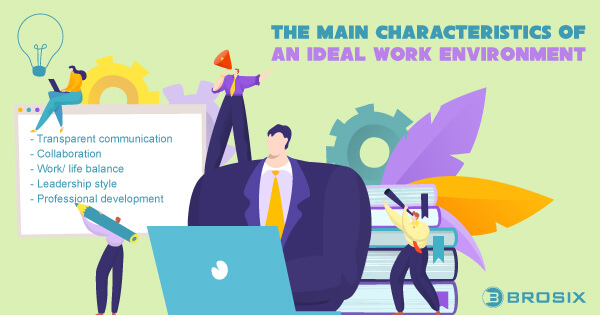The question “what is your ideal work environment?” is becoming increasingly common in job interviews. Today’s talented employees want to work in environments that nurture their creativity, skills and spirit. At the same time, team leaders are searching for dedicated, engaged professionals, who are productive and motivated at work.
Focusing on developing an ideal work environment is an excellent way for business leaders to ensure that they are getting the most out of their teams. Not only does a fantastic workplace generally improve team performance, but it can also nurture collaboration and cooperation, reduce staff turnover and minimize the risk of employee burnout.
Unfortunately, building an ideal work environment isn’t without its challenges. Companies and business leaders need to understand the requirements of their employees, cultivate the right company culture and even think about how they can overcome common team challenges.
Here’s what you need to know about developing the ideal work environment for your staff.
What is the Ideal Work Environment? An Introduction
One of the things that makes cultivating an ideal work environment so complex, is that it can be quite difficult to define what “ideal” looks like for your team. An engaging office space, access to fantastic messaging and collaboration tools and a supportive company culture can all be important building blocks. However, even if you excel at delivering all of these things, problems can still emerge.
Often, it’s the intangible things, like relationships between staff and a general sense of wellbeing that make the biggest difference to an employee’s experience of the workplace.
Essentially, there’s no one-size-fits-all definition of an ideal workplace. When asked “what is your ideal work environment?” some people quote remote working opportunities or environments that offer excellent development support. Others focus more on fantastic software and technology.
In general, an ideal work environment is one where team members feel supported and engaged. Staff should have all of the tools they need to do their best work, feel inspired by their leaders and be comfortable working with their colleagues in collaborative settings.
The Main Characteristics of an Ideal Work Environment

While the definition of an ideal work environment is likely to vary for each employee, there are core factors which influence whether a workplace is nurturing and empowering for teams. Primarily, the main areas you’ll need to focus on as a business leader include:
- Transparent communication: Teams need to be able to communicate effectively to work well, and feel included in the company culture. Excellent communication is a must.
- Collaboration: Staff shouldn’t just “cooperate” in the ideal work environment, they should be able to work seamlessly with their team members in a range of different ways.
- Work/life balance: Positive work environments support the wellbeing of their teams, ensuring that they can find the right balance between work and personal life.
- Leadership style: The leadership style of managers and supervisors has a strong impact on company culture. Leaders should be supportive and motivational.
- Professional development: In any work environment, employees need to be able to consistently build new skills and access sources of useful education.
How to Create an Ideal Work Environment
Building an ideal work environment often takes time, focus and collaboration. Business leaders need to listen to their staff, understand their needs and implement tools and strategies that ensure employees feel supported and engaged.
Fortunately, there are some easy ways to start developing a more effective workplace:
Step 1: Prioritize Transparent Communication
Transparency is essential to an ideal work environment. Not only does it strengthen communication between teams, but it paves the way for a stronger sense of trust between staff members. The more employees can trust both each other, and their business leaders, the more “psychologically safe” they’re likely to feel within the organization.
Business leaders should focus on cultivating a culture of honesty within their workplace. Think about how you can ensure everyone stays in the loop, with regular updates and announcements related to business changes, insights into company values and visions, and consistent access to information.
Encourage business leaders and managers to share as much information as possible with their colleagues, so everyone can stay on the same page.
Step 2: Develop and Train Employees

No matter the industry, every employee wants to see opportunities for growth in their workplace. As the world evolves, it’s crucial for business leaders to offer access to training, education and development opportunities as often as possible.
Consistently training teams on everything from soft skills like communication, to technical skills, like how to use new tools and technology, can deliver a number of benefits. Firstly, when employers invest in their teams, staff members are more likely to feel engaged and motivated by the workplace, turnover will fall and employee retention will rise.
Secondly, developing and training employees ensures that they can continue to perform effectively in their role. They’ll be able to utilize their new skills to be more productive and efficient in the workplace.
Step 3: Motivate and Inspire Teams
Motivation is crucial to creating an ideal workplace. Today’s employees want more than just a wage from their roles, they want to feel as though their work is meaningful and appreciated. To deliver this, business leaders need to take the time to get to know their staff.
Find out what inspires your employees, and what goals they want to achieve throughout their professional lives. Share insights into the values and vision of the business and ensure that employees can see the impact their work is having on the organization. Regular feedback and recognition can go a long way towards making teams feel more invested in their work.
Train business leaders on how to interact with team members, inspire them to reach their goals and keep them focused on the larger collaborative vision. The more motivated and inspired your employees are, the more productive they’re likely to be.
Step 4: Invest in Strong Communication
As mentioned above, an ideal workplace thrives on excellent communication. This not only means ensuring that teams can connect with each other using a range of tools such as messaging apps, video conferencing services and team meetings. It also involves creating a culture of two-way feedback, where employees can honestly share their feedback with business leaders and contribute to overcoming challenges in the business.
Create a space where staff members can communicate openly and honestly on a consistent basis, in the format they feel most comfortable with. For instance, the Brosix platform offers access to a range of tools for collaboration and communication, from voice and video calls, to meetings, instant chat and even file sharing and whiteboarding.
At the same time, make sure employees can preserve their work-life balance, by silencing communications when they’re away from the office. Giving teams the power to turn off messages and reject meeting requests, when necessary, can help to reduce the risk of burnout.
Step 5: Cultivate Collaboration

Finally, teams don’t just need to be able to communicate effectively in an ideal work environment, they need to be able to work together well too. Excellent collaboration is the key to a synergistic and effective workplace, where teams can benefit from the strengths of their colleagues.
Of course, collaboration doesn’t just happen by chance. Business leaders need to make sure they’re nurturing and investing in excellent team experiences. Tools like Brosix can help with this, by offering ways for teams to share ideas and knowledge easily, wherever they are. However you’ll also need to think about how you can motivate staff to work together consistently.
Implementing team building exercises into the workplace, hosting regular meetings where everyone can get involved and encouraging staff from different workplace groups to collaborate are great ways to create a more inclusive, diverse culture.
Build the Ideal Work Environment
Ideal work environments aren’t developed overnight. They’re built, brick by brick, by business leaders who listen to their employees and teams committed to preserving company culture. However, by following the steps above you can start to enhance the quality of your workplace.
Commit to cultivating excellent communication and collaboration, invest in providing your staff members with the right tools and technology and make sure you always pay attention to the needs of your employees. Over time, you and your staff members will create the ideal work environment together.






